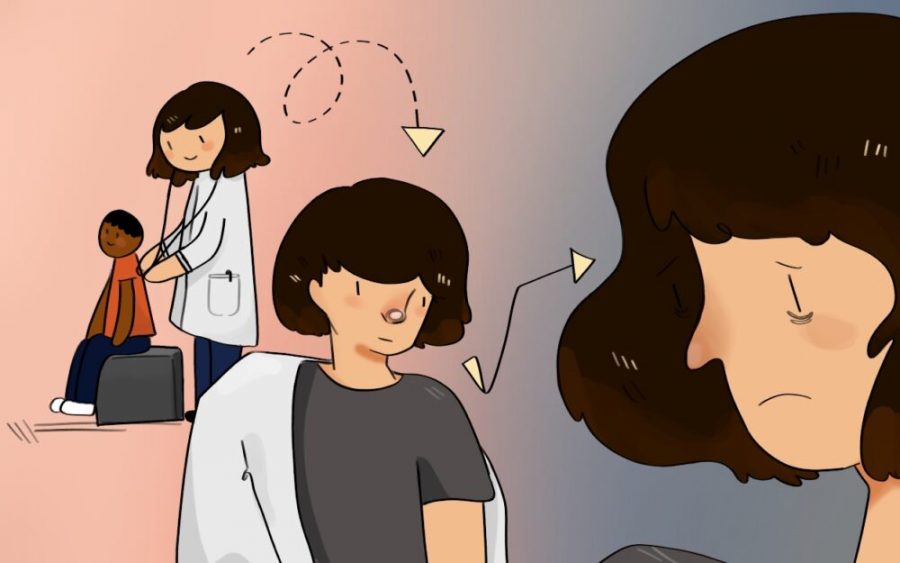In her Columbia Area Career Center class Professions in Healthcare, senior Lucy Bozoian and other students log clinical hours at The Bluffs and The Neighborhoods nursing homes. There, they change wounds, accompany residents to the restroom, take vital signs and perform other essential tasks.
During their time at the assisted living facilities, Bozoian said accidents occur, such as when a patient broke his nose, and they had to call 911.
“We also had a resident fall, which anytime they fall, you have to report it to the state, and you have to check their vital signs,” Bozoian said. “It’s just a lot. It can be chaotic at times.”
About 15.6% of nurses have feelings of burnout and 41% feel unengaged at their jobs, according to the government agency Professional Regulation Commision’s 2019 National Nursing Engagement Report. In fields where emotional support is necessary — medicine, teaching and social work — individuals are especially vulnerable to burnout and other stress-related phenomena such as compassion fatigue and secondary traumatic stress. These conditions connect to high-stakes environments like a medical setting.
Bozoian said she hopes to become a Certified Registered Nurse Anesthetist (CRNA), filling a much-needed nursing position, as the U.S. will likely face a shortage of 95,000 nursing assistants by 2025. CRNAs work in hospitals, although they can work domestically or internationally, a perk of which Bozoian finds appealing. They typically operate in a surgical operating room (OR), where they administer anesthesia to patients.
“I do think that working in an OR can be stressful,” Bozoian said. “I mean, somebody’s life is on the line.”
In the Professions in Healthcare class, students help residents for 100 hours throughout the year in order to earn qualifications to become a Certified Nursing Assistant (CNA) and gain practical experience.
Bozoian said although the majority of the nurses who work at the assisted living facilities care about their residents, she has noticed some of them acting unprofessionally by not putting as much care into their patients as they could. She said she thinks this is because of the stressful and tiring responsibilities they endure every day coupled with a relatively low pay. CNAs, the type of nurses that typically work at nursing homes, are entry-level nurses who earn an average of $28,530 per year, according to the U.S. Bureau of Labor Statistics. Compared to physicians, who make an average of $237,000 or hospital administrators, who average at $103,680 per year, nurses are far more stressed.
A study cited in British Medical Journal found 66% of nurses experienced high burnout, “far more than that of physicians [and] administrative staff,” who reported burnout 38.6% and 36.1% of the time, respectively. The explanation for why nurses are so much more burned out is because they must put high efforts into their jobs while dealing with poor satisfaction and stressful working conditions, according to an article in the U.S. National Library of Medicine. While physicians must also cope with the same environment, they are compensated with a larger paycheck and more autonomy over their decisions. Conversely, administrators are removed from high-risk tasks, and instead focus on managing staff.
In addition to nursing, social service, government activity that promotes the welfare of communities, is a demanding profession as well; an article from the research journal Administration and Policy in Mental Health reports high levels of stress and burnout among social workers because of their role in delivering support in highly sensitive contexts. People like Missouri Department of Social Services Program Development Specialist Sherry Moller, who works in the Children’s Division, typically advocate for people vulnerable to abuse, harm or mental issues.
In order to cope with this mental strain, hospitals and other places of work can implement programs regarding workplace stress through their Human Resources (HR) departments. HR refers to the management and development of employees in an organization. Mike Koehler, the Chief Human Resources Officer of University of Missouri — Columbia Healthcare, leads many executive decisions and has direct contact with workers at employee roundtables.
“We do quite a bit to help our people manage stress,” Koehler said. “We have an Employee Assistance Program (EAP) where employees can talk with a mental health professional confidentially for help on either business or personal-life issues. We also have peer networks for people to support their colleagues after stressful events.”
The University of Missouri System’s EAP lists levels of intervention for the prevention and management of stressors. Primary prevention, the first level, takes action to promote a positive working environment and identifies specific stressors, which employees assess through self-report questionnaires. Secondary prevention trains employees to manage and recognize the symptoms of psychological disorders such as depression and anxiety. The final stage, tertiary prevention, focuses mainly on rehabilitation and recovery through counseling.
Through EAPs, places from offices to hospitals can assist their employees with mental and physical health. Counselling is about providing a sounding board for personnel to talk about troubling issues, according to Personnel Today, a website that provides workplace well-being advice. Counselling is less about giving advice and more about providing an accessible means to allow an employee to find a way forward from personal problems.
“In addition to the resources we provide, what’s even more important is that our people are supportive of each other,” Koehler said. “Peer-to-peer support, recognition and gratitude run high here, and I can’t think of anything more important to help deal with workplace stress than having your co-workers surround you with care when needed.”
Do you want to go into a helping profession? Let us know in the comments below.













































































